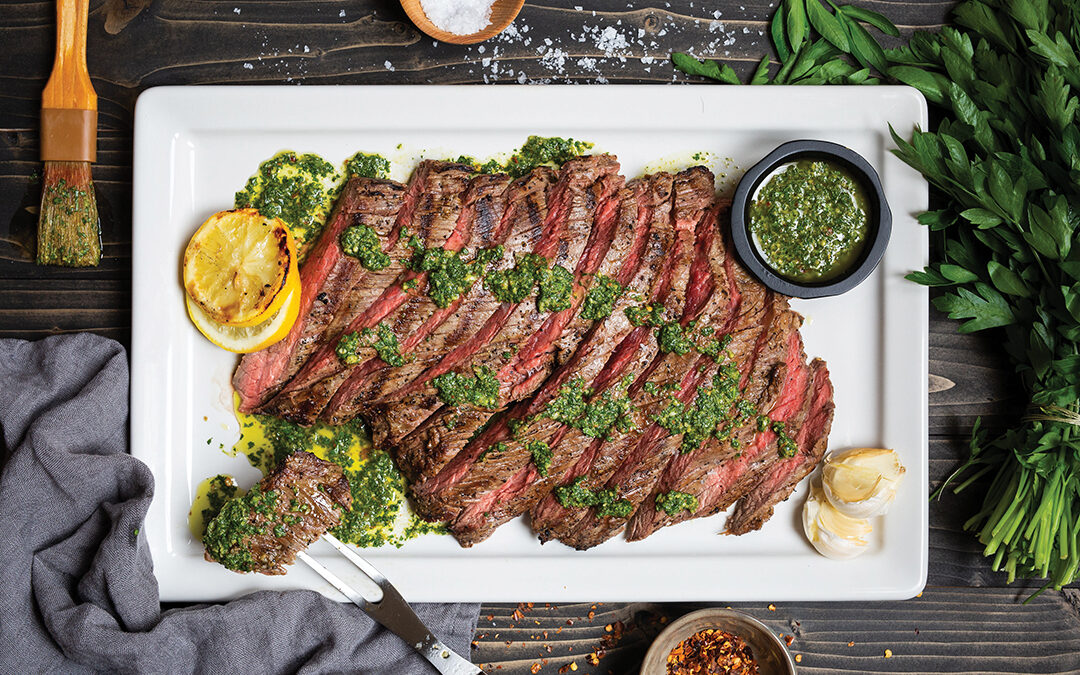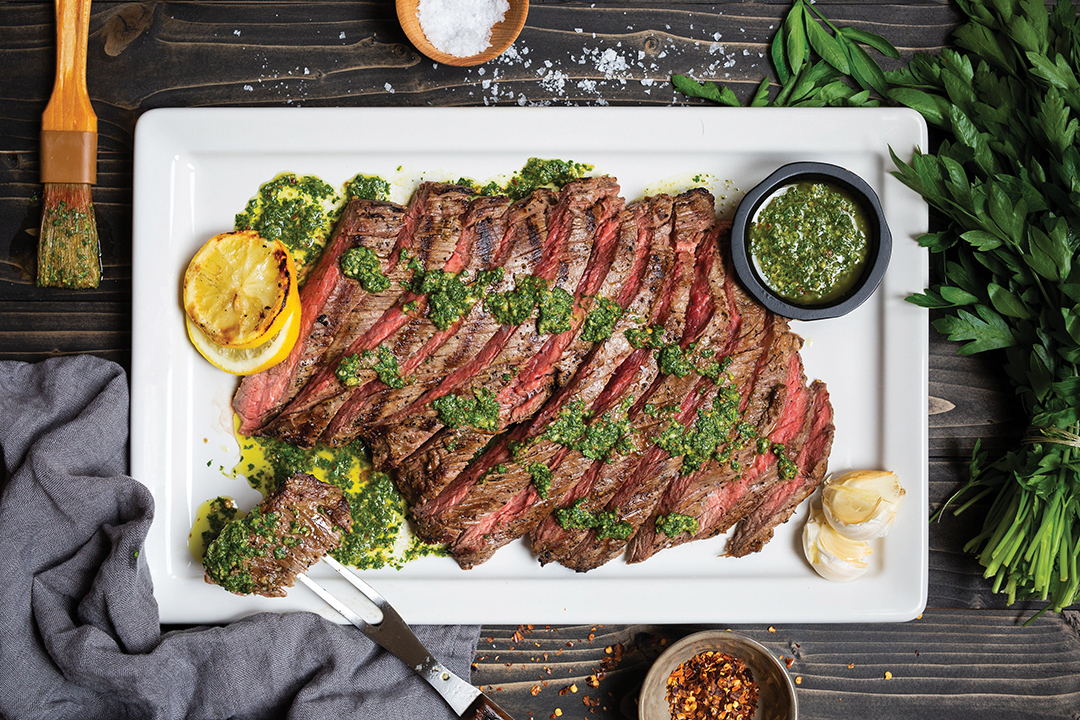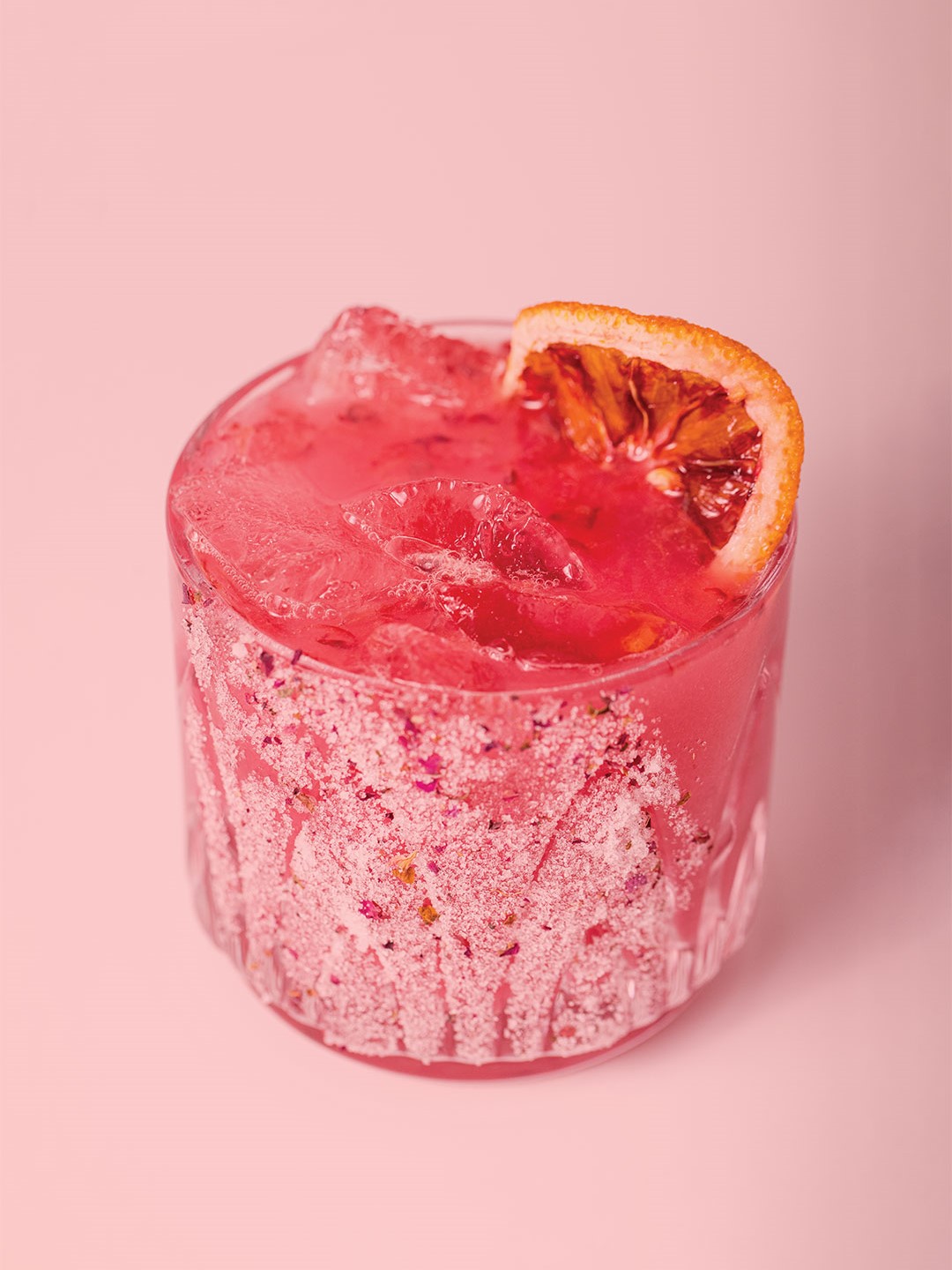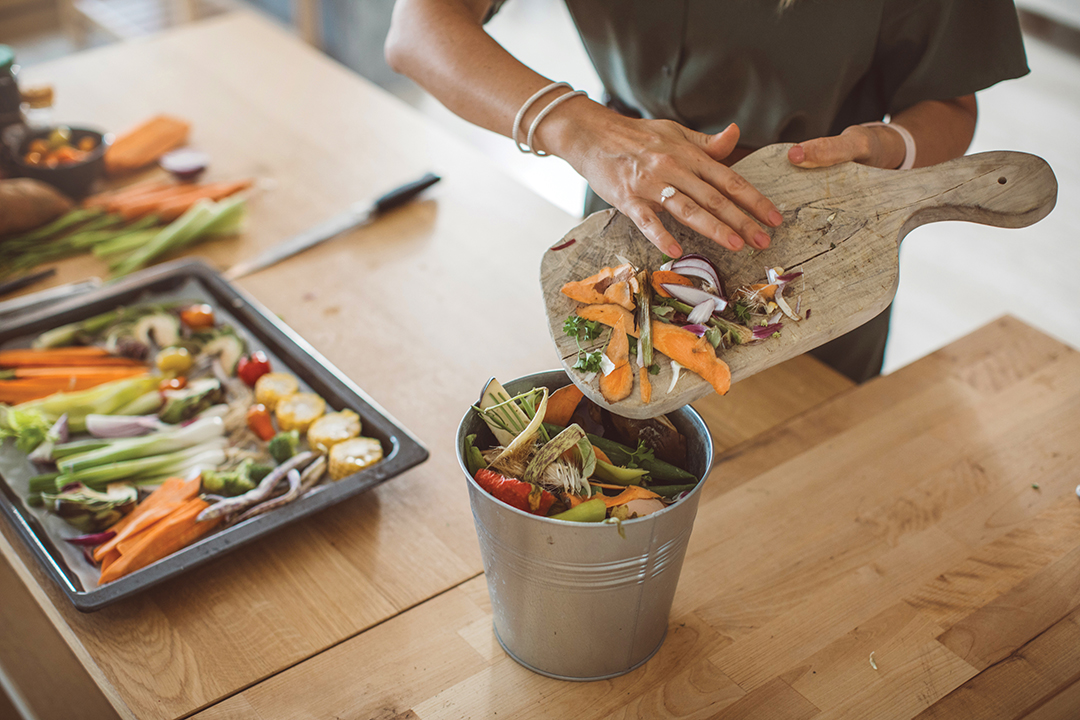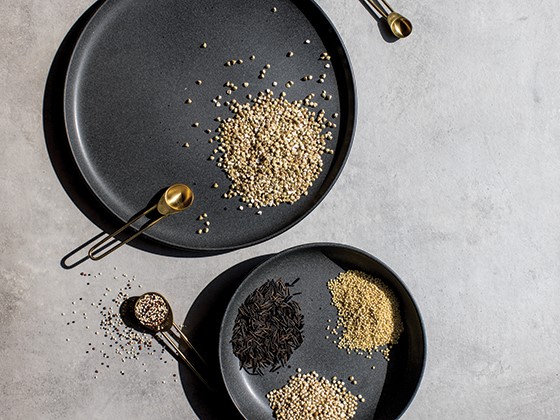
Photos: Chris Emeott
Add a touch of history, new flavor profiles and textures to your menu.
Why does pasta get so much of the culinary glory? Granted, it transforms dishes, comes in shapes galore and has “comfort food” written all over it. But since we’re in the midst of high cooking season (for entertaining purposes, a dose of hygge or otherwise), let’s take a closer look at grains—including some emerging trend makers and recipes to keep you ahead of the grain game.
*Reader tip: Stick with the article until the end. We’ve got a kernel of info for you that might just put everything you know about a certain homegrown grain right on its head!
Who better than Caroline Sluyter, The Whole Grains Council program director, to clear up some grainy questions?
What constitutes a whole grain? A grain that is whole contains all three edible components (bran, germ and endosperm) in their original proportions.
What are refined grains? Grains that are missing some portion of their original kernel are considered refined grains. Typically, when grains are refined, some or all of their bran and germ are removed. Since most of a grain’s nutrients and flavor are found in the bran and germ, refined grains are both less nutritious and less flavorful than whole grains.
Is there such a thing as “faux grains,” meaning not from the Gramineae family? Quinoa, amaranth and buckwheat are pseudocereals. While they are not in the Poaceae (or Gramineae) botanical family, they are generally considered grains alongside true cereal grains because their nutritional profile, preparation and use are so similar.
Is there an emerging grain trend we should know about? … Of the products registered for Whole Grain Stamp (containing at least half a serving or eight grams or more of whole grain) over the past 10 years, there are five clear frontrunners when it comes to growing popularity. Perhaps the most illustrious of all is quinoa … [It] is now included in more than 10 percent of all Stamped products. Sorghum has also made impressive gains with its prevalence increasing more than threefold in 10 years. The other top contenders are millet, amaranth and teff.
What are the top five grains that offer the most nutritional benefits? There is no “healthiest” grain, just as there is no healthiest vegetable. You’ll never hear a doctor tell you to stick to carrots and spinach, even though they both have great nutritional attributes. Just as variety is key when eating fruits and vegetables, the best way to take advantage of the health benefits of whole grains is to eat a wide variety. Every grain has a little something different to offer.
Which grains serve as protein and fiber powerhouses?… Most whole grains qualify as a good source of protein (providing at least 10 percent of the Daily Value for protein per serving). The pseudo-cereals (quinoa, buckwheat and amaranth) are all “complete” protein sources, which means they contain significant amounts of all nine essential amino acids.
Whole grains are somewhat famous for their fiber content. Again, you’ll find that almost every grain variety qualifies as either a good source of fiber (providing at least 10 percent of the Daily Value for fiber per serving) or excellent source of fiber (providing at least 20 percent of the Daily Value for fiber per serving).
How can we incorporate more grains into our diets? Making easy swaps by substituting in whole grain versions of foods you already eat is certainly one of the easiest ways to increase your whole grain intake without having to think too hard about it. Use whole grain bread instead of white bread, brown rice (or farro and quinoa) instead of white rice and whole grain pasta instead of white pasta. When baking, try substituting half of the all-purpose flour in your recipe with whole grain flour. Many consumers new to whole grains are quite pleasantly surprised at the wonderful depth of flavor you get by using whole wheat or whole spelt in place of white flour.
Four to Know
Information is provided by The Whole Grains Council. Recipes can be found at wholegrainscouncil.org.
Amaranth: Technically a pseudo-grain, it’s a staple of the Aztecs with a long history in Mexican and Peruvian cuisine (later becoming popular in Nepal, India and other countries). It’s typically served as breakfast porridge throughout Latin America and Southeast Asia. In Mexico, it’s also served popped with honey as a sweet snack called alegría. Flavor Profile: Peppery with a sweet, grassy aroma; pairs well with squash, corn, sesame, cinnamon, vanilla and chocolate. Gluten-free.
Millet: This is one of the leading staple grains of India and was also used in ancient Chinese noodles before wheat was domesticated. Nutritious millet is also important to the cuisines of South America, Russia, the Himalayas and Africa. Flavor Profile: Buttery; pairs well with mushrooms, herbs, warm spices, scallions and squash. Gluten-free.
Sorghum: (also called milo), Sorghum is believed to have originated in Africa, where it remains an important cereal grain. It is naturally drought tolerant, making it a smart choice for diners eating with their environmental footprint in mind. Flavor Profile: Sweet with hints of corn or wheat flavor; pairs well with Southern ingredients (bananas, berries, bourbon, dates, figs, ham, peanuts, pecans and warm spices). Gluten-free.
Teff: A tiny (less than 1mm) grain native to the Horn of Africa, where nomads could carry enough teff seed in their pockets to sow an entire field. Its name may come from the Amharic word for “lost” because the seed is so tiny. Flavor Profile: Slightly sweet taste with undertones of cocoa and hazelnut; pairs well with chocolate, dark fruit, nuts, pumpkin and seeds. Gluten-free.
*Wild Rice: You’ve had it in a hotdish, you’ve eaten it in a salad or as a pilaf, but have you ever in your wildest rice dreams ever considered popping it? Yes, you can pop wild rice, like popcorn. Just heat it in a little oil, and shake it until it pops. Salt to taste. Movie time? (thespruceeats.com)
Millet Salad
Serves 4-6
This can be an ideal salad to prepare with leftover turkey or ham from a holiday meal.
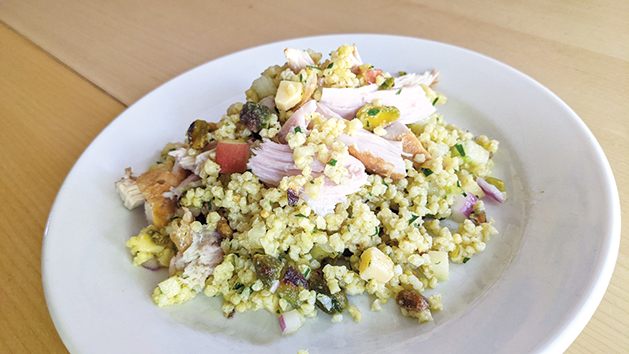
- 1 cup millet (about 4 cups cooked)
- 2 cups chicken stock/water
- ½ cup shelled pistachios, roasted and chopped
- ½ cup sweet red apple (gala or honey crisp), small diced, or dried cranberries
- ½ cup smoked Gouda, small diced
- ¼ cup celery, small diced
- ¼ cup red onion, small diced
- ¼ cup Italian parsley, minced
- 2 cups smoked turkey, shredded, or ham, diced (optional)
Dressing:
- ¼ cup fresh-squeezed lemon juice
- zest from lemon
- ½ cup olive oil
- 1 Tbsp. Dijon mustard
- 1 Tbsp. maple syrup or honey
- ¼ tsp. salt
- ¼ tsp. pepper
Place a medium-size sauce pot heat over medium-high heat. Add millet, and stir frequently to slightly toast about 2-3 minutes. Watch carefully as it can burn easily. When it becomes slightly fragrant, add stock/water. Bring mixture to a boil, and reduce heat to low. Cover the pot, and simmer for 20 minutes. Turn off heat, remove cover and allow to cool for 10 minutes.
In a large bowl, combine all dressing ingredients, and whisk well. Add all remaining salad items to the bowl. After millet has rested, fluff with a fork, and add to bowl. Gently toss, mixing well to combine all ingredients with the dressing. Store in an airtight container. For best flavor, allow salad to sit overnight.
Teff Chocolate Cake with Fudge Frosting
This is a rich and indulgent cake that is still moist and fluffy. Made with healthy fats, nutritious grains and naturally gluten free, it is almost too good to be true. If you want a vegan option, just leave out the egg. –Rachel Sherwood
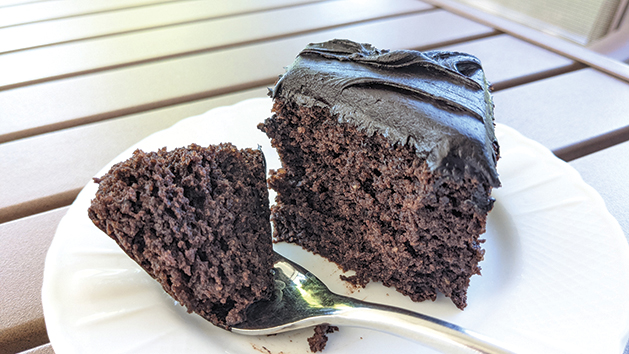
Photo: Rachel Sherwood
- 1 soft large avocado (½ cup mashed)
- 1 medium banana (½ cup mashed)
- 1 cup teff flour
- 1 cup almond flour
- ¼ cup arrowroot
- ¼ good quality dark chocolate cocoa powder
- 3/4 cup coconut sugar (White sugar will work, too.)
- 1 tsp. baking powder
- 1 tsp. baking soda
- 1 tsp. cinnamon
- 1 tsp. vanilla
- ¼ tsp. salt
- 1 egg
- 1 cup full-fat coconut milk
Chocolate Fudge Frosting
- ½ cup good quality dark chocolate cocoa powder, sifted
- ¼ cup honey
- ¼ cup full-fat coconut milk
- 1 tsp. vanilla
Preheat the oven to 350 F. Grease and line an 8-9-inch square or round cake pan with parchment paper. In the bowl of a large food processor, combine the avocado and banana, processing until smooth. Combine all remaining ingredients in bowl of the food processor. Process for 10-second intervals until all ingredients are well combined, scraping down sides as needed.
Pour batter into prepared pan, and bake for 55 minutes until toothpick inserted in the center comes out clean. Remove the pan from the oven, and allow the cake to cool in pan for 15 minutes before removing to a wire rack.
To make frosting, combine all ingredients in a small bowl, and stir with a fork until smooth and spreadable. The frosting’s consistency will vary slightly depending on the temperature of the room. If needed, thin the frosting by adding more coconut milk.
When cake is cooled, spread frosting evenly over the top of the cake, allowing it to drip over the sides. This cake is best eaten the same day, but it can be stored in an airtight container.
Puffed Amaranth Granola
Makes about 4 cups
Puffed amaranth makes a light slightly nutty gluten free granola. Note: you can buy amaranth already popped online. However, if you make it yourself the subtle nuttiness is more pronounced. See notes below on how to pop your own amaranth.–Rachel Sherwood
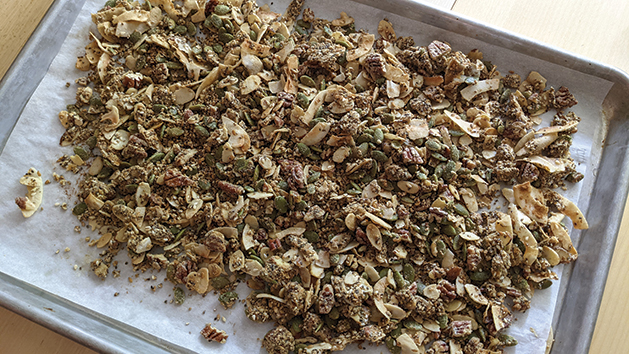
Photo: Rachel Sherwood
- 2-3 Tbsp. raw amaranth seeds popped (about ½ cup popped seeds)
- ½ cup sliced almonds
- ½ cup chopped pecans or walnuts
- ½ cup pumpkin seeds or sunflower seeds
- 1/2 cup large unsweetened coconut flakes
- 2 Tbsp. sesame seeds or hemp seeds
- 2 Tbsp. chia seeds or golden flax seeds
- ¼ cup maple syrup or honey
- ¼ cup almond butter, sun butter, cashew butter or peanut butter
- 1-2 tsp. cinnamon
- 1 tsp. vanilla
- ¼ tsp. salt
- ½ cup dried fruit (cranberries, chopped cherries or apricots), optional
Preheat oven to 325 F. Line a rimmed baking pan with parchment paper. Lightly spray a large mixing bowl with oil. Combine the popped amaranth, almonds, pecans, coconut, sesame seeds and chia seeds in prepared bowl. In a small pan over low heat, combine the almond butter and maple syrup, stirring just until smooth. Remove from heat, and add the vanilla, cinnamon and salt, stirring to combine. Pour warm mixture into a bowl, mixing gently until well coated. Pour coated mixture onto prepared pan. Bake for 20-25 minutes, until slightly toasted, stirring half way though the baking time. Remove from oven; allow to cool. Store in an airtight container. Serve with yogurt, as an ice cream topping or add milk and eat like cereal.
To Pop Amaranth: Preheat a high-sided pot over medium-high heat. Spread 1 Tbsp. at the time as evenly as possible on the bottom of the hot pot. Wait for the seeds to pop. If they don’t pop right away, the pot wasn’t hot enough and the seeds won’t pop and just burn. Discard that batch, and start over. Once the popping starts, shake the pot, keeping it close to the heat to ensure all seeds pop and the popped seeds don’t burn. Once the puffing ceases, remove the popped amaranth, and allow to cool. Repeat process until all the seeds have been popped. For every tablespoon of raw amaranth, you’ll get about 2-3 Tbsp. of popped amaranth.
More Tips: Use a deep stock pot to keep seeds contained when they are actively popping. Temperature is key to a successful popped amaranth. You want the seed to puff immediately. If they sit on the bottom of the pan, they will burn. I recommend heating your pan over medium heat for 2-3 minutes then test a few seeds before adding an entire spoon, so you don’t waste too much. Too hot and they all pop but burn quickly. Not hot enough and they don’t pop but just burn. Don’t over crowed the pan. Remember, the heat is key to success if you have too many seeds, they will not pop well. Even in a large stock pot, I only pop 1 tablespoon of seeds at a time. Once you get the right temperature, this is quick and easy. Shake or quickly stir the pot often to get the seeds moving to the hot spots. A high-quality pan with a heavy bottom will help with even heat distribution.
Plymouth’s Rachel Sherwood, food stylist and culinary coach, offers recipes to help expand your grain repertoire. See more of her recipes, kitchen adventures and tips at impressionsathome.com.
Facebook: Impressions Foodstyling

